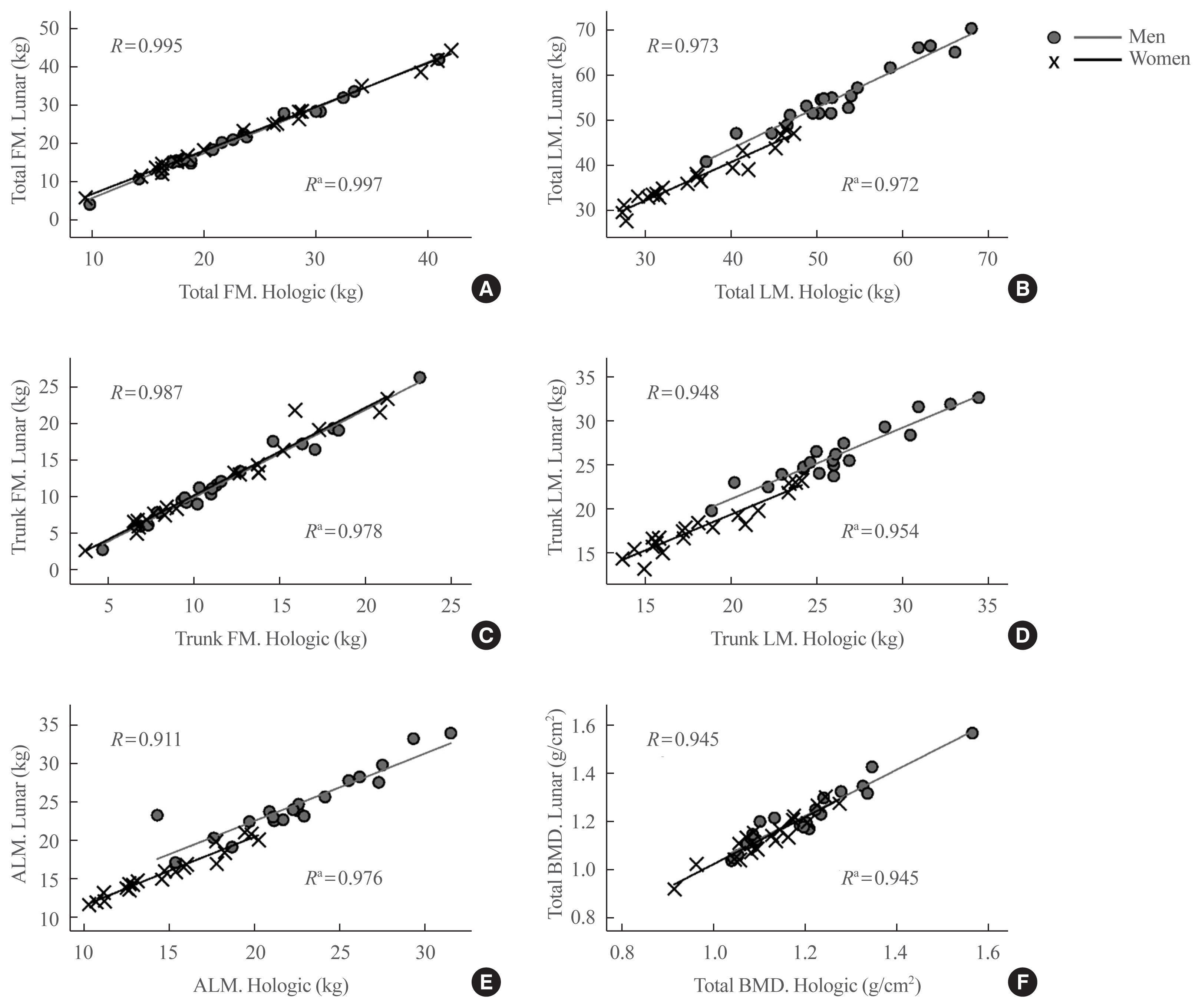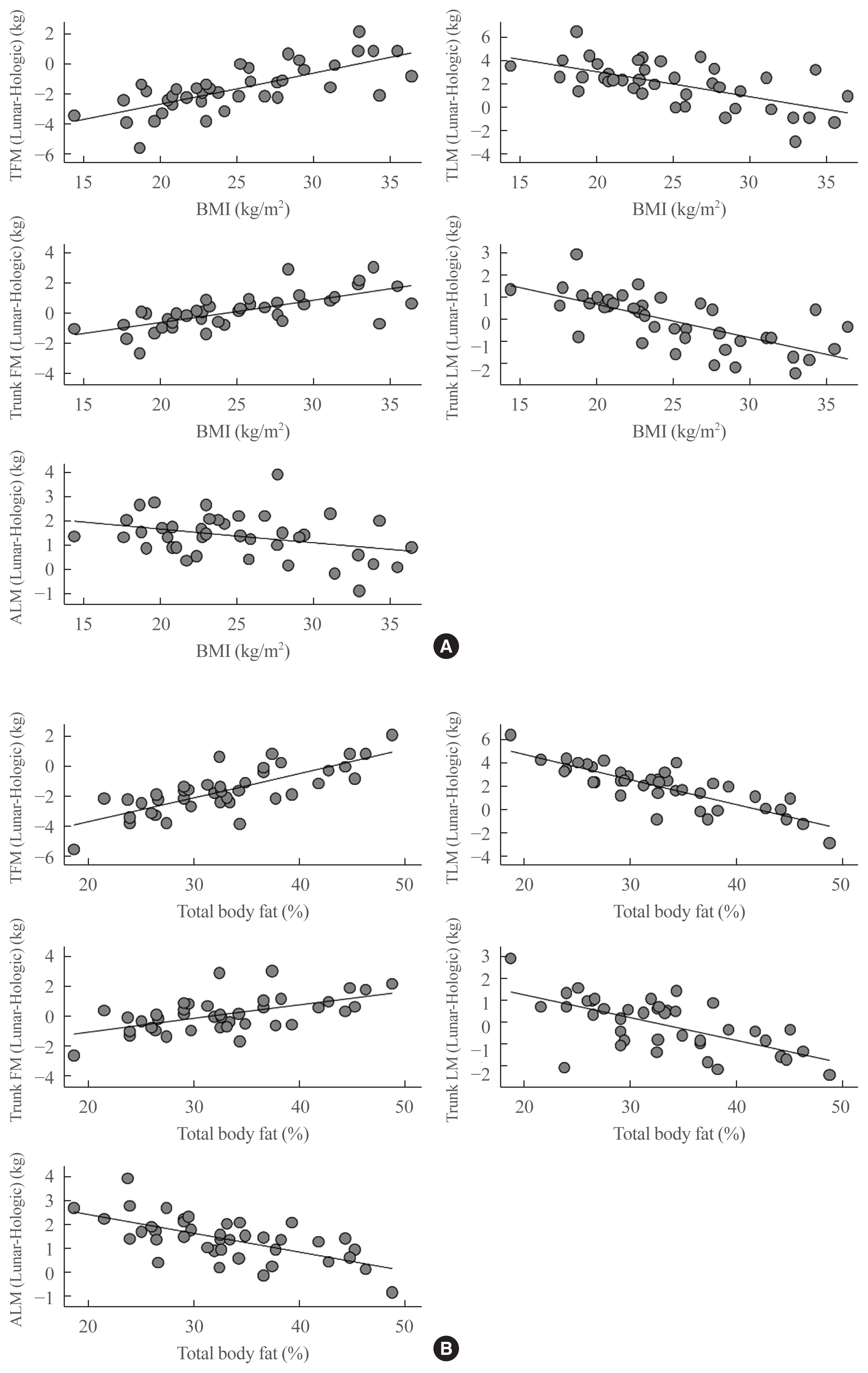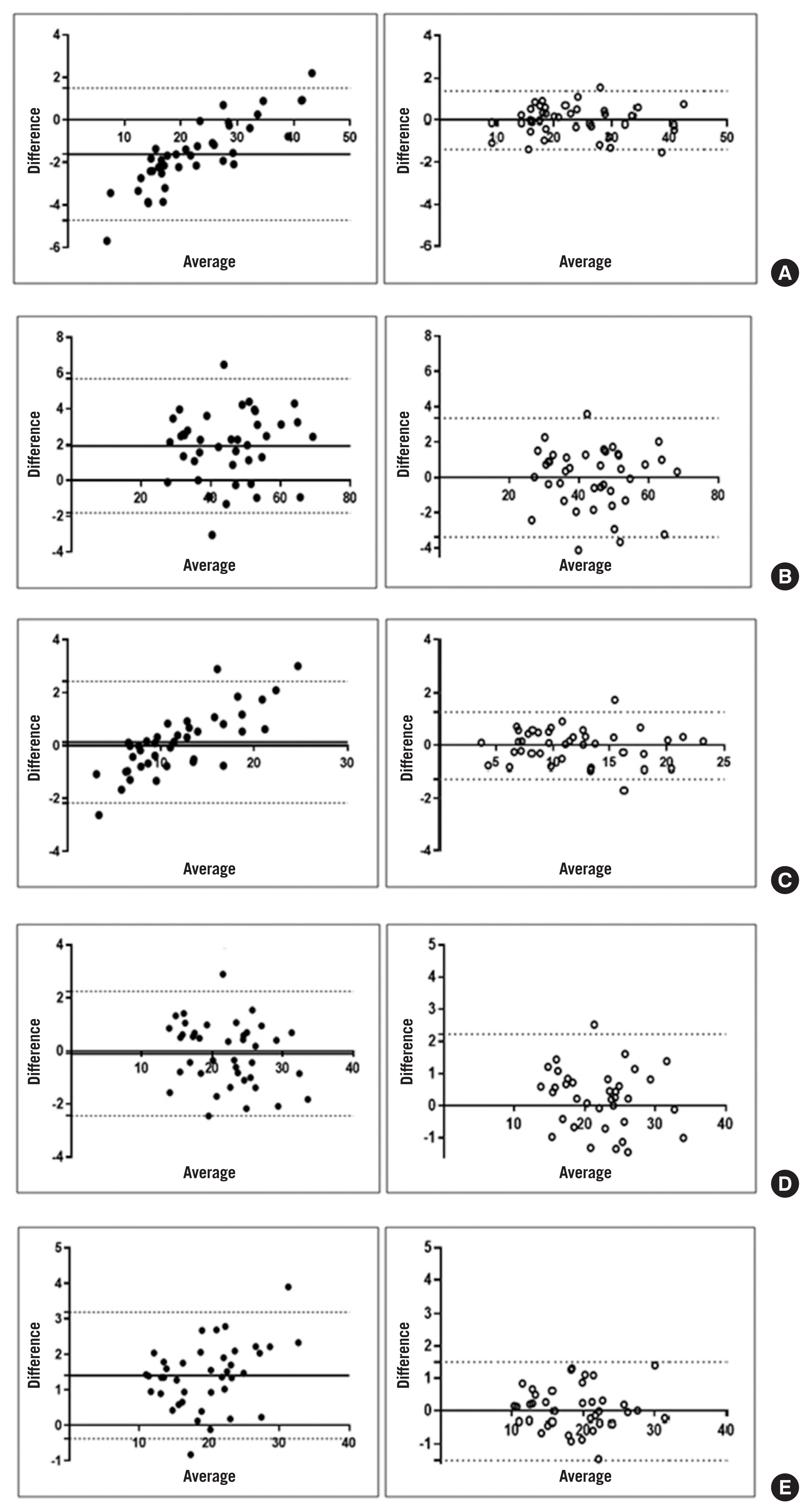Endocrinol Metab.
2021 Dec;36(6):1219-1231. 10.3803/EnM.2021.1274.
Comparison of Two DXA Systems, Hologic Horizon W and GE Lunar Prodigy, for Assessing Body Composition in Healthy Korean Adults
- Affiliations
-
- 1Department of Internal Medicine, Seoul National University Bundang Hospital, Seoul National University College of Medicine, Seongnam, Korea
- 2Biomedical Research Institute, Seoul National University Bundang Hospital, Seongnam, Korea
- 3Division of Endocrinology, Department of Internal Medicine, Yongin Severance Hospital, Yonsei University College of Medicine, Yongin, Korea
- KMID: 2523491
- DOI: http://doi.org/10.3803/EnM.2021.1274
Abstract
- Background
Dual-energy X-ray absorptiometry (DXA) is the most widely used method for evaluating muscle masses. The aim of this study was to investigate the agreement between muscle mass values assessed by two different DXA systems.
Methods
Forty healthy participants (20 men, 20 women; age range, 23 to 71 years) were enrolled. Total and regional body compositional values for fat and lean masses were measured consecutively with two DXA machines, Hologic Horizon and GE Lunar Prodigy. Appendicular lean mass (ALM) was calculated as the sum of the lean mass of four limbs.
Results
In both sexes, the ALM values measured by the GE Lunar Prodigy (24.8±4.3 kg in men, 15.8±2.9 kg in women) were significantly higher than those assessed by Hologic Horizon (23.0±4.0 kg in men, 14.8±3.2 kg in women). Furthermore, BMI values or body fat (%), either extremely higher or lower levels, contributed greater differences between two systems. Bland-Altman analyses revealed a significant bias between ALM values assessed by the two systems. Linear regression analyses were performed to develop equations to adjust for systematic differences (men: Horizon ALM [kg]=0.915×Lunar Prodigy ALM [kg]+0.322, R2=0.956; women: Horizon ALM [kg]=1.066×Lunar Prodigy ALM [kg]–2.064, R2=0.952).
Conclusion
Although measurements of body composition including muscle mass by the two DXA systems correlated strongly, significant differences were observed. Calibration equations should enable mutual conversion between different DXA systems.
Keyword
Figure
Reference
-
1. Goodpaster BH, Park SW, Harris TB, Kritchevsky SB, Nevitt M, Schwartz AV, et al. The loss of skeletal muscle strength, mass, and quality in older adults: the health, aging and body composition study. J Gerontol A Biol Sci Med Sci. 2006; 61:1059–64.
Article2. McGregor RA, Cameron-Smith D, Poppitt SD. It is not just muscle mass: a review of muscle quality, composition and metabolism during ageing as determinants of muscle function and mobility in later life. Longev Healthspan. 2014; 3:9.
Article3. Landi F, Cruz-Jentoft AJ, Liperoti R, Russo A, Giovannini S, Tosato M, et al. Sarcopenia and mortality risk in frail older persons aged 80 years and older: results from ilSIRENTE study. Age Ageing. 2013; 42:203–9.
Article4. Nieuwenhuizen WF, Weenen H, Rigby P, Hetherington MM. Older adults and patients in need of nutritional support: review of current treatment options and factors influencing nutritional intake. Clin Nutr. 2010; 29:160–9.
Article5. Baumgartner RN, Waters DL, Gallagher D, Morley JE, Garry PJ. Predictors of skeletal muscle mass in elderly men and women. Mech Ageing Dev. 1999; 107:123–36.
Article6. Meng SJ, Yu LJ. Oxidative stress, molecular inflammation and sarcopenia. Int J Mol Sci. 2010; 11:1509–26.
Article7. Nilwik R, Snijders T, Leenders M, Groen BB, van Kranenburg J, Verdijk LB, et al. The decline in skeletal muscle mass with aging is mainly attributed to a reduction in type II muscle fiber size. Exp Gerontol. 2013; 48:492–8.
Article8. Cruz-Jentoft AJ, Landi F, Topinkova E, Michel JP. Understanding sarcopenia as a geriatric syndrome. Curr Opin Clin Nutr Metab Care. 2010; 13:1–7.
Article9. Yoo JI, Choi H, Ha YC. Mean hand grip strength and cut-off value for sarcopenia in Korean adults using KNHANES VI. J Korean Med Sci. 2017; 32:868–72.
Article10. Jin WS, Choi EJ, Lee SY, Bae EJ, Lee TH, Park J. Relationships among obesity, sarcopenia, and osteoarthritis in the elderly. J Obes Metab Syndr. 2017; 26:36–44.
Article11. Cruz-Jentoft AJ, Baeyens JP, Bauer JM, Boirie Y, Cederholm T, Landi F, et al. Sarcopenia: European consensus on definition and diagnosis. Report of the European Working Group on Sarcopenia in Older People. Age Ageing. 2010; 39:412–23.
Article12. Heymsfield SB, Gonzalez MC, Lu J, Jia G, Zheng J. Skeletal muscle mass and quality: evolution of modern measurement concepts in the context of sarcopenia. Proc Nutr Soc. 2015; 74:355–66.
Article13. Chien MY, Huang TY, Wu YT. Prevalence of sarcopenia estimated using a bioelectrical impedance analysis prediction equation in community-dwelling elderly people in Taiwan. J Am Geriatr Soc. 2008; 56:1710–5.
Article14. Sun G, French CR, Martin GR, Younghusband B, Green RC, Xie YG, et al. Comparison of multifrequency bioelectrical impedance analysis with dual-energy X-ray absorptiometry for assessment of percentage body fat in a large, healthy population. Am J Clin Nutr. 2005; 81:74–8.
Article15. Bilsborough JC, Greenway K, Opar D, Livingstone S, Cordy J, Coutts AJ. The accuracy and precision of DXA for assessing body composition in team sport athletes. J Sports Sci. 2014; 32:1821–8.
Article16. Kim J, Wang Z, Heymsfield SB, Baumgartner RN, Gallagher D. Total-body skeletal muscle mass: estimation by a new dual-energy X-ray absorptiometry method. Am J Clin Nutr. 2002; 76:378–83.
Article17. Xu W, Chafi H, Guo B, Heymsfield SB, Murray KB, Zheng J, et al. Quantitative comparison of 2 dual-energy X-ray absorptiometry systems in assessing body composition and bone mineral measurements. J Clin Densitom. 2016; 19:298–304.
Article18. Lu Y, Fuerst T, Hui S, Genant HK. Standardization of bone mineral density at femoral neck, trochanter and Ward’s triangle. Osteoporos Int. 2001; 12:438–44.
Article19. Hui SL, Gao S, Zhou XH, Johnston CC Jr, Lu Y, Gluer CC, et al. Universal standardization of bone density measurements: a method with optimal properties for calibration among several instruments. J Bone Miner Res. 1997; 12:1463–70.
Article20. Hind K, Oldroyd B, Truscott JG. In vivo precision of the GE Lunar iDXA densitometer for the measurement of total body composition and fat distribution in adults. Eur J Clin Nutr. 2011; 65:140–2.
Article21. Oldroyd B, Treadgold L, Hind K. Cross calibration of the GE Prodigy and iDXA for the measurement of total and regional body composition in adults. J Clin Densitom. 2018; 21:383–93.
Article22. Sutter T, Duboeuf F, Chapurlat R, Cortet B, Lespessailles E, Roux JP. DXA body composition corrective factors between Hologic Discovery models to conduct multicenter studies. Bone. 2021; 142:115683.
Article23. Buford TW. Sarcopenia: relocating the forest among the trees. Toxicol Pathol. 2017; 45:957–60.
Article24. Tothill P, Hannan WJ, Wilkinson S. Comparisons between a pencil beam and two fan beam dual energy X-ray absorptiometers used for measuring total body bone and soft tissue. Br J Radiol. 2001; 74:166–76.
Article25. Watson L, Venables M, Singh P, Murgatroyd P. An investigation into differences in body composition measurements between two GE Lunar densitometers and in comparison to a four component model. J Clin Densitom. 2015; 18:432–3.26. Kaminsky LA, Ozemek C, Williams KL, Byun W. Precision of total and regional body fat estimates from dual-energy X-ray absorptiometer measurements. J Nutr Health Aging. 2014; 18:591–4.
Article27. Plank LD. Dual-energy X-ray absorptiometry and body composition. Curr Opin Clin Nutr Metab Care. 2005; 8:305–9.
Article28. Ganda K, Nguyen TV, Pocock N. Gender disparity in BMD conversion: a comparison between Lunar and Hologic densitometers. Arch Osteoporos. 2014; 9:180.
Article29. Kim KM, Jang HC, Lim S. Differences among skeletal muscle mass indices derived from height-, weight-, and body mass index-adjusted models in assessing sarcopenia. Korean J Intern Med. 2016; 31:643–50.
Article30. Shepherd JA, Fan B, Lu Y, Wu XP, Wacker WK, Ergun DL, et al. A multinational study to develop universal standardization of whole-body bone density and composition using GE Healthcare Lunar and Hologic DXA systems. J Bone Miner Res. 2012; 27:2208–16.
Article31. Chen LK, Woo J, Assantachai P, Auyeung TW, Chou MY, Iijima K, et al. Asian Working Group for Sarcopenia: 2019 consensus update on sarcopenia diagnosis and treatment. J Am Med Dir Assoc. 2020; 21:300–7.
Article32. Lee SY, Ahn S, Kim YJ, Ji MJ, Kim KM, Choi SH, et al. Comparison between dual-energy X-ray absorptiometry and bioelectrical impedance analyses for accuracy in measuring whole body muscle mass and appendicular skeletal muscle mass. Nutrients. 2018; 10:738.
Article
- Full Text Links
- Actions
-
Cited
- CITED
-
- Close
- Share
- Similar articles
-
- Cross-Calibration of Bone Mineral Densities and Body Composition between GE Lunar Prodigy and Osteosys Primus
- Open, Active-Controlled Clinical Study to Evaluate the Correlation between Whole Body DEXA and BIA Muscle Measurements
- Muscle mass measurements in hip fracture patients and control general population depending on dual-energy X-ray absorptiometry device used: The General Electric Lunar and Hologic systems
- Cross-calibration of Bone Mineral Density between Two Different Dual X-ray Absorptiometry Systems: Hologic QDR 4500-A and Lunar EXPERT-XL
- Standardization for Dual Energy X-ray Absorptiometry




